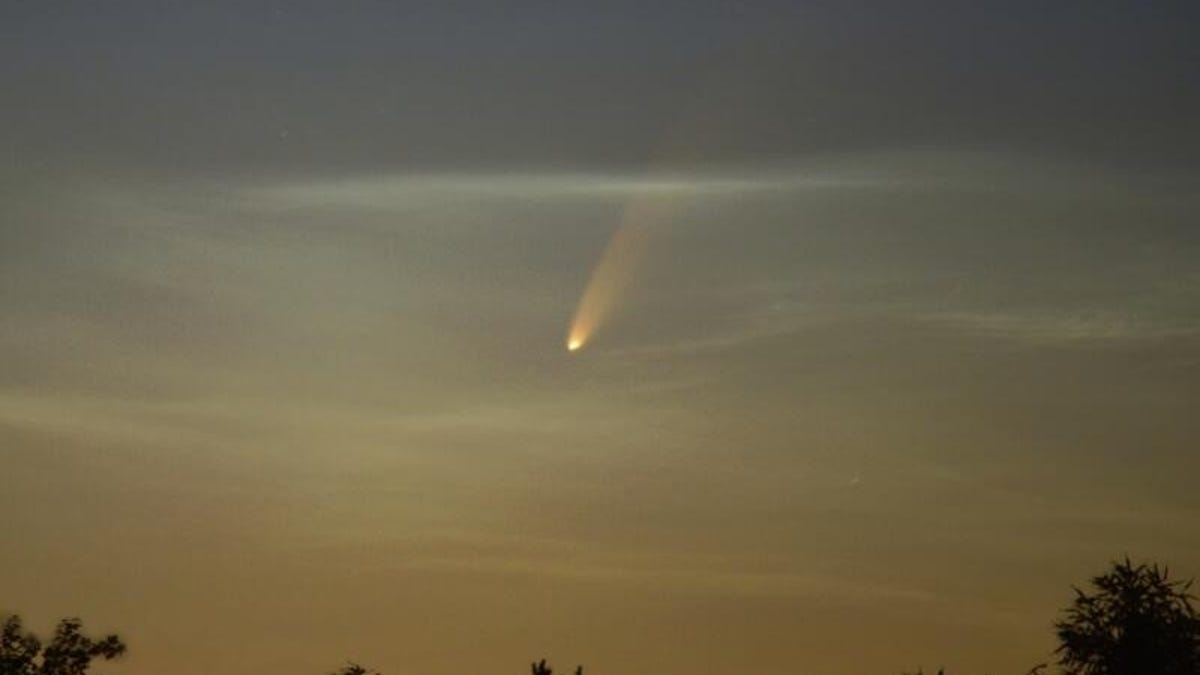How to see fading comet Neowise before it leaves for 6,000 years
One of the most spectacular comets in decades still offers a rare opportunity for skywatchers, but the window's closing.

Comet Neowise as seen from the Czech Republic on the morning of July 6.
Comet Neowise, the most impressive comet in nearly 25 years, is giving sky watchers a last chance to catch it. The comet made its closest pass by Earth on Thursday and rose a little higher in the sky on July 24 and 25. From that point it's likely to get dimmer as it returns to deep space.
Emily Kramer, co-investigator on the science team for the NASA Neowise spacecraft that discovered the comet, noted that it's rare for a comet to be bright enough to see with the naked eye. "It's been quite a while," she told reporters last week. "The last time was 1995-1996 (with comet Hale-Bopp)."
Over the past couple of weeks, a number of amateur astrophotographers have shared stunning images of the comet captured as it appeared just above the horizon in predawn skies.
I have a strong dislike of early mornings—but so worth it today because wow is that comet beautiful! C/2020 F3 (NEOWISE) I was at Sunset Crater by 4AM. It was an easy naked-eye object, but really rewarding through binoculars. Last pic is closest to naked eye scale.#neowise pic.twitter.com/1I0Cx2fZQJ
— Jeremy Perez (@jperez1690) July 5, 2020
Comet NEOWISE and the city of Toronto, Ontario, Canada 🍁! I was up really early for this shot. It's not often that we get the opportunity to see or photograph a comet of this brightness and with a tail. I hope you like it!🤩 https://t.co/BFyxFFw2DE pic.twitter.com/sGZBiEVryM
— Kerry LH💫 (@weatherandsky) July 5, 2020
Astronauts on the International Space Station have also spotted the comet, aided by their premium vantage point, and NASA's Parker Solar Probe captured the profile of Neowise, showing it has multiple tails.
Comet NEOWISE from ISS, July 5th pic.twitter.com/qDjDGdmgfe
— TheSpaceAcademy.org✨🔭 (@ThespaceAcad) July 11, 2020
According to NASA solar system ambassador Eddie Irizarry, the comet should be easier to see this week as it climbs a little higher in the sky. There are beginning to be a few reports, however, of Neowise growing more faint, so don't delay.
During the weekend, i traveled to one of the darkest places in my country, #Terschelling, where I captured #cometNEOWISE
— Raymond Kamstra (@kamstra_raymond) July 13, 2020
Here's a single shot i took with the comet, and some nice #bioluminescence @helgavanleur @StormchaserNL @mrmiddendorp @weermanreinier @WilliamHuizinga pic.twitter.com/1LUoecsOj0
Right now, the advice being shared by many of those who have successfully spotted the comet is to first locate it in the sky using binoculars or a telescope. Once you've found it and its trademark split tail, you should be able to then track it with the naked eye.
July 5 - my third consecutive morning observing Comet NEOWISE. When I held my 7x40 binoculars to my eyes to search for...
Posted by Fred Espenak on Sunday, July 5, 2020
There's still a slim possibility, for the most optimistic of us, that Neowise might brighten dramatically to become a so-called "great comet" that's easily visible and spectacular to see with the naked eye. While there's no strict definition of what a great comet is, it's generally agreed that we haven't seen one since Hale-Bopp.
Beautiful Declan Deval image.
— Con Stoitsis (@vivstoitsis) July 12, 2020
Comet Neowise over Stonehenge UK on the 10th. pic.twitter.com/kgKe4E2rFG
The comet will be visible toward the northwest and western edges of the sky. A good rule of thumb is to find the big dipper and start looking below it.
Here's where you can spot the comet. Online resources like TheSkyLive also offer similar night sky maps to aid your comet quest.
This diagram from Sky and Telescope shows where to look for comet Neowise in the night sky this month.
If you don't see the comet before it inevitably fades away in August or sooner, you'll have to wait awhile for its next trip through the inner solar system, currently estimated to happen in the year 8786.

